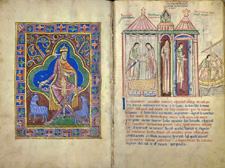Image
© Hildesheim, St Godehard |
ALEXIS QUIRE
The Chanson of St Alexis is preceded by a unique illustration
painted in delicate washes. The scene is a continuous narrative, proceeding
in separate episodes from left to right. In the first scene, Alexis gives
his bride parting gifts of a ring and sword-belt, medieval signs of fidelity.
They stand above an untouched marriage bed and the dove of divine inspiration
guides Alexis towards his departure. Above them, in lines of alternating
red and green, are the Latin words ‘Blessed Alexis, the chosen youth’
and ‘O blessed wife, forever bound to grief’. The ‘p’
of puer electus was smudged and written again.
Central to the entire composition, larger than the other figures and,
most unusually almost full face, the bride stands weeping in the doorway.
Her hand is on her cheek. Above her are the consoling words ‘The
final gifts are given to the chaste bride. The ring and sword-belt, the
end of words and hail!’
In the next scene, Alexis gladly steps out from his home. The doors are
clearly shown as a hybrid of the harr hung variety, with their sockets
fully visible at their base, and C shaped strap hinges. Alexis then boards
a ship, paying the boatman his fare, and the hand of God emerges from
the ship’s sail to bless his departure. The final caption reads
‘The blessed Alexis is received into the ship’.
The iconography of this picture appears to be unique but other early illustrations
of the Alexis cycle, focussing on the later stages of the story, exist.
The eleventh-century wall paintings in San Clemente, Rome show the end
of the legend, significantly depicted in continuous narrative backed by
the arches of a scenae frons, as in the psalter (AP, 120, pl
141a). While Pächt explores exotic sources for the Alexis Master’s
iconography (Roman wall paintings and sarcophagi) he deliberately rejects
a source much closer to home (AP,120-122; Pächt, 1962, 59,n2).
Illustrated versions of the Comedies of Terence were well known in England
at this date and their dramatic conventions thoroughly understood (Jones
and Morey, 1931; Dodwell, 2000, 101-154). The most relevant example, Oxford,
Bodleian Library, Auct.F.2.13, made around 1150 actually belonged to St
Albans in the early thirteenth century (Thomson, 101, 35). Whether the
Alexis Master ever saw the Bodleian Terence is irrelevant here: he clearly
understood the conventions of its model. The Terence illustrations derive
directly from performance in the Roman theatre. They appear like a short
frieze across the page, comprising a sequence of episodes and conversations.
In early versions (like Paris, Bibliothèque Nationale Lat. 7899,
ninth century) the scenery is schematic, limited to the occasional door
frame constructed of slender posts and lintel. In the Romanesque Bodleian
version, this scenery has solidified to splendid sequences of elaborate
edicules with fancy roofs and elaborate doors and hinges. Very similar
buildings to the Alexis are shown in the Bodleian f4v, while f9v even
shows a farewell taking place in the doorway. The gesture of Alexis’
bride, curled hand to cheek, is a convention of Roman drama (Dodwell,
2000, XIV, XL,74-8, 111-122), regularly employed in Anglo-Saxon art. The
final close connection with the Comedy illustrations is the use and positioning
of captions just above the protagonists’ heads, particularly clear
on the Bodleian Terence f30v.
If the Alexis Master was aware of an illustrated Terence when he composed
the Alexis scenes, he was probably also aware of it when he constructed
the initial for Psalm 18 (p.104). Both show
a bridegroom coming out of his marriage chamber, with similar building,
gestures, movement and meaning.
Note the story itself is in French while the captions which explain the
picture are in Latin. The prologue is written in alternating lines of
red and blue ink, with the blue capital introducing a red line. The captions,
which were added after the illustration was complete, alternate red blue
and green lines in the same fashion as the added caption on p69.
See also The
Alexis Quire: its illustrations, and the discourse on Good and Evil
and Textual Commentary on the
Old French Life of St Alexis and Gregory’s Letter
First page of quire
5

Click
to enlarge
|
![]()